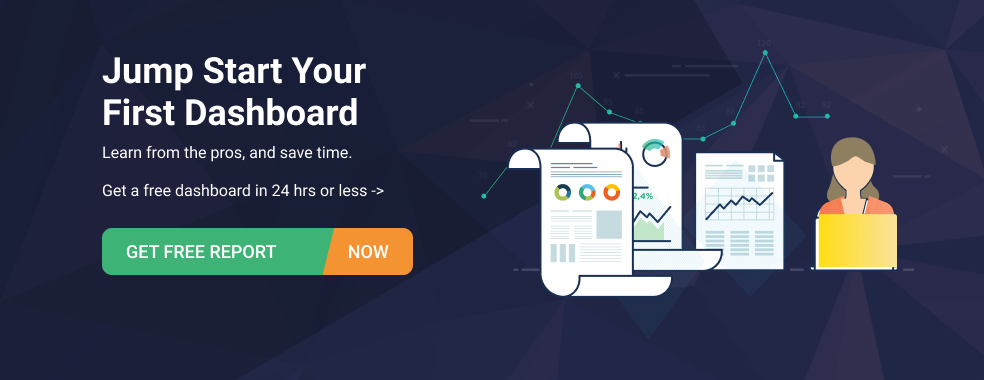Table of contents
Small business owners wear many hats. CEO, COO, CFO, and many more. If you’re one of them, you know what I’m talking about. It’s impossible to fill every role well, so you must streamline your day, every day. That means spending as little time as possible on report generation and as little budget as possible on fancy tech solutions.
Those two goals would seem to be at odds with each other. After all, technology is here to make your life more efficient, right? The question is, which technology can you afford that will really turn things around when it comes to critical performance reporting and access with a minimum of effort?
I know what you’re thinking. This is just another ad for Databox, right? I promise I won’t mention Databox again. This is about you and what you need to do to stay on top of your business.
So let’s dive in.
Basic Financial Health Reports
You make decisions every day that impact your bottom line. How are you doing at customer acquisition, revenue growth, customer acquisition cost, general and administrative costs, and profitability? You need to know the facts in order to make smart decisions, and you need to have the right data at your fingertips to decide. Fortunately, you can easily build a small business dashboard that’s tied into your most recent, or even real-time, data and systems. Like this one created for a small marketing agency from Google Sheets:
The good news is that this data can be compiled into a single Google Sheet (or more than one) that’s easy to update or feed from other business systems that you use regularly. Here are some great tips on small business uses of Google Sheets. Once your Sheet(s) are set up, it’s easy to connect them to dashboards that you can view anytime or share with your leaders and teams by email or Slack.
Now, what to do with your daily or weekly performance update? Again, the good news is that you now have additional time saved from data collection and report creation. Put it to good use reviewing short-term and long-term trends. Look for positive and negative changes, inflection points, and anomalies. Consider why these are happening. Bounce ideas off your trusted employees and partners. Make your move. This is how small businesses stay ahead of the competition.
Sector Reports
Nearly all businesses have teams, or at least specialists, in certain roles, such as sales, marketing, product, and customer service. Most have team leaders whose responsibility is to meet their team goals and align with overall business goals. As the business owner, you want to keep tabs on progress towards both types of goals, but creating specific reports for each team on anything but a quarterly cadence is out of the question for you and for your team leaders. Let’s drill down on an example of a small business sales report.
The thing is, with sales or any other mission-critical part of your business, quarterly reporting is too late. Change happens much more frequently than that. The most dramatic example I can think of was the Spring, 2020 Covid-19 pandemic, as it grabbed the U.S. economy by the throat. The swoon in overall sales was both rapid and extreme. Waiting until the end of Q2 to recognize and make changes to your sales tactics would have been (and was) disastrous for many small businesses. This highlights the importance of dashboards in providing real-time insights that allow businesses to adapt quickly to changing circumstances.
Could you have seen this coming by viewing your daily sales performance dashboards and correctly sensing the oncoming fear of in-person engagement?
It’s an interesting question, but surely now we are far more sensitive to big swings than before 2020, and we are tuning in to our business data early and often.
Human Resources Reports
What’s the most valuable asset any small business has? Your people, of course.
Knowing this, very few small businesses have dedicated HR resources, so it may be difficult for a business owner to understand what’s going on among the ranks. Still, there are things you can do to keep your fingers on the pulse of your people, for example:
- Short Surveys. Ask a question or two that gives you insights into how your people are coping and thriving.
- One-On-Ones. Talk to your employees as often as you can. Get to know them and ask them how you can improve the business and their experience.
- Net Promoter Score surveys. Maybe once a quarter, find out how your employees feel about your business and what’s working and not working.
- Slack Channels. Throw a few questions out to your general channels to see how your people feel and what they see coming in your market. What are your big challenges and new opportunities?
There are quite a few affordable apps for collecting employee engagement data that can make this process simple. You can incorporate as much of this data as you can in automatically updated Google Sheets and create KPI dashboards that monitor employee sentiment and highest priority issues. Meet with your team leaders to discuss these insights and plot a course for improving them over time.
Nobody in their right mind ever said that owning a small business is easy. Quite the opposite in fact.
Should you decide to accept it, your mission is to focus on the really important stuff while making sure that the small stuff gets done too and tracking your most valuable KPIs using a small business dashboard software.
That means you need to spend most of your time on strategy, deal-making, people decisions, and customer acquisition. But you also need accurate and timely data and reports with a minimum of effort.
Like what you saw in this article? Sign up for a free account and we will build your first performance dashboard for you.














